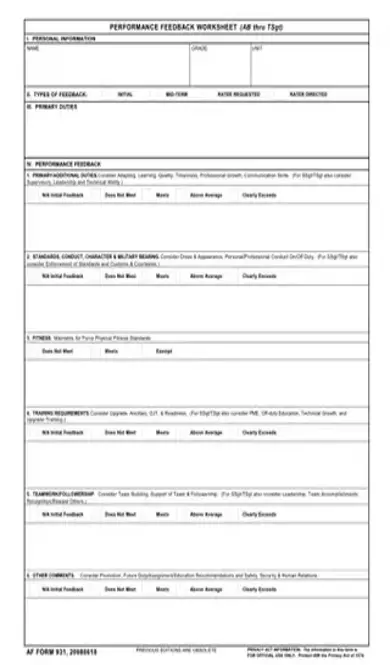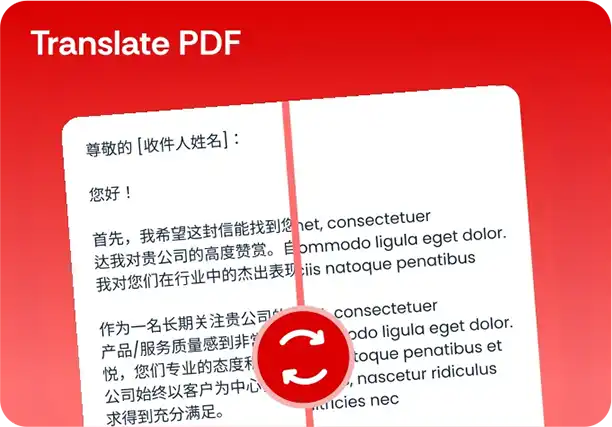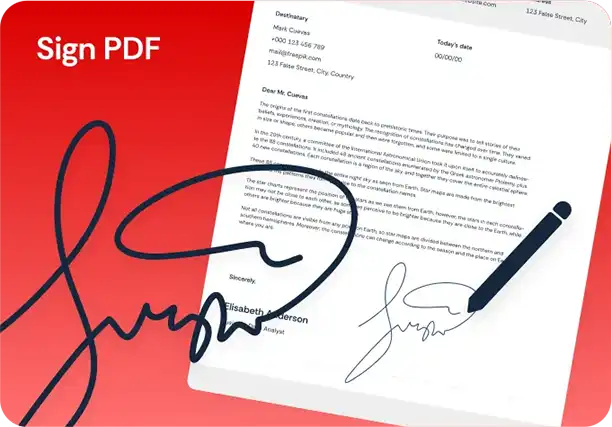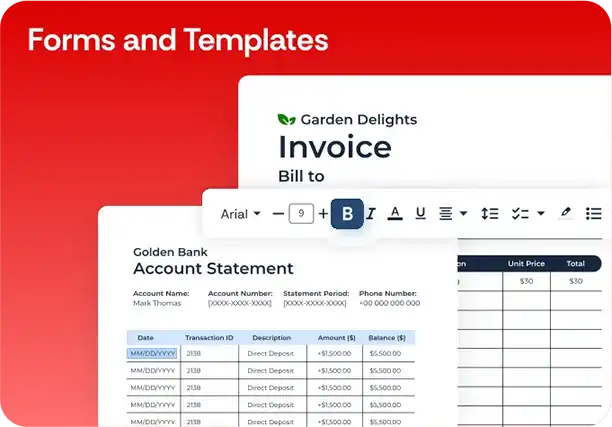AF 931 PDF Template
Stop searching and find out why people love the ease of creating beautiful and legally compliant AF 931 PDF with PDFSimpli.

Stop searching and find out why people love the ease of creating beautiful and legally compliant AF 931 PDF with PDFSimpli.





[toc] For members of the Air Force, training is rigorous and full of learning opportunities. You’re meant to come through each day knowing more and feeling stronger than you did the day before. There are a number of different ways that supervisors can connect with their trainees. One of them is with AF Form 931 PDF which it’s definition is a comprehensive assessment worksheet that allows supervisors to give a judgment regarding their charges. PDFSimpli‘s service let’s you edit this form and fill it out. It will work for both ios and android devices. We review previous editions and make sure we have the latest form for you. You will find instructions within the form so you can fill it out.
The supervisor uses this form to assess the skill levels and competence of a ratee. For each ratee, performance feedback is given through a private counseling session with the supervisor. The supervisor will explain the expectations for duty performance, and then assess how well the ratee is meeting these requirements.
In most cases, this feedback is considered private between the supervisor and the ratee. However, there are cases in which the ratee is TSgt through AB. In these cases, the rater who rated the supervisor also has the authorization to read the report. Additionally, the Commander has access to all the performance feedback sheets for any grade of Airmen. This is all part of the code on how the performance report must be done.
This performance feedback form is used by people in the Air Force. There are two main Air Force performance feedback forms; this is the one designed for use by AB through TSgt Airmen.
The responsibility of filling out the form is with the supervisor who rates the ratee. This rater can either type or handwrite the report. With a free PDF document, it’s easy to type in the information fields. Each completed form is meant to outline whatever issues were discussed throughout the feedback session.
It would require a great deal of writing to record every aspect of a feedback session, so for the sake of practicality, raters are not expected to record every topic they discussed or word they said. With that in mind, raters should capture their key concerns from each session.
If the ratee is surprised by a low rating, they may later claim that whatever issue caused said low rating was not brought up during previous periodic feedbacks. However, it’s important for ratees to understand that omitting an issue from the official report is not proof that there was no discussion of this issue.
Performance Feedback Worksheets are used throughout the Air Force for Airmen of every classification. A ratee will first encounter the form during their initial assessment. Forms are used periodically after that.
All Air Force trainees will experience feedback in the form of performance worksheets. Their first feedback will come prior to the form’s completion, when they have their private counseling session with their supervisor. It’s important that the supervisor complete the worksheet as soon as possible following the session. This worksheet is the documentation explaining that the feedback session existed. It’s also concrete documentation of any areas that need improvement.
If a supervisor fails to file a performance worksheet, their ratee will never find out what rating they received. The supervisor could also be subject to disciplinary action for neglecting their paperwork.
The form will be completed by the rater following the private feedback session. Part I should feature the personal information of the ratee, including their name, rank, and unit. Part II defines the type of assessment. You have five choices: initial, mid-term, follow-up, ratee requested, and rater directed.
An initial assessment is done when a trainee first begins their Air Force life. A mid-term assessment happens partway through training, while a follow-up assessment occurs sometime during the period after the mid-term assessment. “Ratee Requested” indicates that the ratee asked to have their performance evaluated, while “Rater Directed” indicates that the supervisor specifically ordered the performance feedback to be completed.
Part III is the self-assessment portion, which the ratee will fill out themselves. They’ll then forward their answers to the rater. The rating scale includes Y for yes and N for needs more information.
Part IV is completed by the rater and details the critical role the ratee has to support their mission. After the rater talks to the unit deployment manager, they can complete Part V. The Individual Readiness Index has R for red, meaning the trainee is not ready for deployment. G stands for green, indicating that the trainee is ready to be deployed.
Part VI is the main performance rating. For each of the numbered skills and positive qualities, the rater should check the box that most resembles the ratee’s performance. The bottom of the page, Box 6, is an open space left specifically for comments. If the rater wants to qualify or mention anything else, that’s the box to use.
A followership and leadership assessment is the main component of Part VII. It’s set up similarly to the performance assessment. For every skill and trait, the rater must check the box resembling the ratee’s leadership and followership qualities. Part VIII regards the entire overall concept of the Airman, evaluating whether the ratee has embraced the core values of the Air Force.
For both Part VII and Part VIII, a comments section is available should the rater need to add more detail or make any qualifying comments.
Part IX is a list of important questions that the rater and ratee should discuss during their counseling session. The rater doesn’t need to record the ratee’s answers. Instead, they should use these questions as a basic guideline during their session.
At the bottom of the document, the ratee and rater should both sign in their respective boxes. The date should be the date the evaluation was completed.[pdf-embedder url=”https://cdn-prod-pdfsimpli-wpcontent.azureedge.net/pdfseoforms/pdf-20180219t134432z-001/pdf/af-form-931.pdf?sv=2018-03-28&si=readpolicy&sr=c&sig=MXHnWmn0sXNXztiU%2Bugk2d7DV7KBCOuXF3oBMx0EeEw%3D”]
They should be done at least three times throughout a training course: at the beginning, during the mid-terms, and in a follow-up session.
The biggest component of the worksheet is the rater’s determination of whether or not the ratee is fit to be deployed.
People with poor ratings won’t be able to go on deployment. They’ll also need to target their weak areas for performance improvement.